MicroStrategy ONE
Components of a report
The image below shows a standard grid report in MicroStrategy.

Rows and columns
On a typical report, each row represents a business concept, such as products, employees, customers, stores, and so on. MicroStrategy calls these business concepts "attributes," because they represent the many important attributes of a business.
Attribute: A business concept that provides context in which data is relevant. In the example of a report that shows sales in the Southeast, Southeast is the attribute. An attribute on a report serves as a label for a group of metrics.
While the rows represent business concepts, the columns of a typical report represent financial calculations that are important to the business, such as inventory, sales, costs, profits, salaries, and so on. MicroStrategy calls these calculations "metrics".
Metric: A calculation that shows the numbers you want to see. In the example of a report that shows sales in the Southeast, sales is the metric. Metric calculations can show information at simple levels as well as at complex levels, such as displaying sales trends, growth patterns, percent-to-total contributions, and profit analysis. A metric on a report shows a list of values used for analytical calculations.
Cells
Each individual cell on a report contains a single value which is produced by calculating data gathered from somewhere in your organization's data source. That data is the focus of business analysis in a reporting environment.
In the report shown above, for example, the revenue forecast for the first quarter of the year (Q1) for your Art & Architecture books (in the first row) is much lower than the revenue forecast for the same books in Q2. This difference may represent a general slump in sales after the US holiday period, or some other customer behavior specific to the retail industry. The analysis of this data might lead to a decision to prepare a sale or other special promotion on Art & Architecture books for Q1, to attempt to counteract the forecasted revenue reduction.
